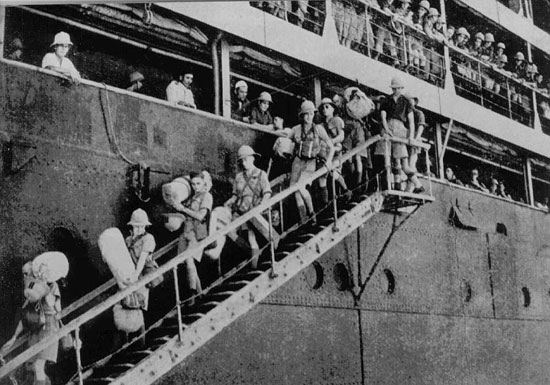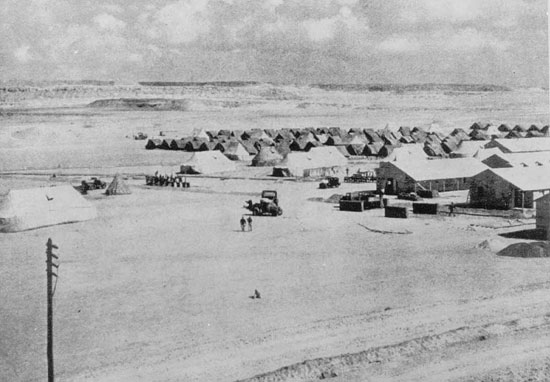Queen's in the Middle East
The Voyage Out
In the Middle East, after the relief of Tobruk, the Eighth Army had pursued the Deutsche Afrika Korps and the Italians back once again to El Agheila on the border of Tripolitania. Here administrative difficulties necessitated a pause. Rommel availed himself of this opportunity to mount a counter-attack on the 21st January 1942, recapturing both Benghazi and Derna, and pushed the Eighth Army back to a fortified position stretching from Gazala on the coast to Bir Hacheim, some 35 miles south in the desert. Here both sides faced each other for several months. In Russia the Germans had managed to hold up a powerful Russian winter counter-offensive, and in some areas were returning to the offensive themselves, whilst in the Far East the Japanese had overrun Burma and the Dutch East Indies, were threatening India with invasion, and were building up their strength in Rabaul and New Guinea as bases for an invasion of Australia.
In this gloomy situation Winston Churchill foresaw the advantage of having a mobile reserve well on its way eastwards to reinforce any of these many fronts as needed, and he obtained agreement from President Roosevelt that the USA would make available shipping to carry two divisions. The destination of these two divisions, the 8th Armoured Division and the 44th Division, was therefore not only secret, but as yet quite uncertain.
The convoy carrying the 44th Division was a large one. In addition to the eight ships carrying the Division there were fifteen other ships in addition to an escort which, to begin with, consisted of the battleship, HMS Nelson, an aircraft-carrier, and a number of destroyers. The 1/6th and the 1/7th Queen’s embarked into the Strathallan, one of the latest P. & O. ships, whilst 1/5th Queen’s embarked in an American ship, the Christobal, together with the 133rd Field Ambulance RAMC and a few members of the Pioneer Corps. Each battalion was complete with full first line reinforcements, so the ships were undoubtedly crowded. The Strathallan held about 5,000 troops, whilst the much smaller 10,000 tons vessel Christobal had about 1,200 troops on board. The weather was a little rough for the first two days and there was a fair amount of sea
sickness among the troops.
It took a little time for 1/5th Queen’s to settle down to a satisfactory routine, primarily due to the numerous links in the chain of command in an American ship being used by British troops. The supreme authority was the Captain, who could only be approached through OC American Troops, a Major Robinson, US Army. He in turn could only be approached through OC British Troops, Lt Col Williams, RIASC. In addition there were a number of ship’s departmental officers who issued orders on their own authority. Since 1/5th Queen’s comprised the bulk of the troops on board, the Commanding Officer, Lt Col Lance East, was determined that this state of affairs should cease, and that a properly organised routine should take its place. This happened in a very short time, basically according to Lt Col East’s wishes. There was extremely little space on board for training, but space was made available so that every man had one period of weapon training and one period of physical training each day. There were numerous lectures and discussions organised by company and platoon commanders, and officers’ discussion periods were held in the evenings two or three times a week. In addition the whole Battalion set itself the task of learning semaphore. There were only two meals a day, breakfast and dinner. This was primarily due to lack of space, each meal taking about three hours before all the troops were fed. However the food was excellent, and the absence of any drink stronger than lime juice was borne philosophically, since the Christobal, like all American ships, was ‘dry’.
The two meal routine was alleviated by an excellent canteen organised by Major R.E. Clarke, which was extremely popular and had ample stocks obtained both before leaving Scotland and at ports of call, and these were sufficient to last the whole voyage. Capt M.A. Berdoe Wilkinson, OC ‘C’ Company, was in charge of entertainments. He had the assistance of the Battalion Band, and nearly every night there was some form of entertainment; a concert; a Brains’ Trust; a whist drive; or housey-housey. A daily News Bulletin was issued so that everyone was informed of what was happening in the outside world. Capt Berdoe Wilkinson worked incessantly to make certain that there was no lack of really good entertainment, and his Saturday Night Concerts produced considerable talent and set a high standard. Throughout the voyage 1/5th Queen’s got on very well indeed with the American crew members.
The Strathallan, being a British ship, was not only ‘wet’, so that beer and sometimes a tot of rum could be issued, but was administered by the well tried system of an OC Troops, assisted by an Adjutant and small staff appointed from the embarked troops, working directly to the commanding officers of each unit aboard. No doubt the resulting routine was similar to that worked out in the Christobal and probably more familiar to those that had been ‘trooping’ before, but maybe a trifle more formal.
After the rough weather had abated the convoy sailed into a fog, which persisted for a day or so, which was no doubt extremely useful in providing a screen from prying aircraft or passing U-boats, When the fog lifted the convoy sailed into some excellent weather which continued throughout the rest of the voyage, although at times it became extremely hot. After 14 days out of sight of land the convoy sailed into Freetown, Sierra Leone, where it stayed for several days. No one was allowed to land, but many people were able to send cables home. General Sir George Giffard, GOC-in-C West Africa, a former CO of 2nd Queen’s and the future Colonel of the Regiment, visited battalions on board. The convoy sailed again on the 20th June, with the additional protection of HMS Nelson’s sister-ship, HMS Rodney, but the aircraft-carrier had by this time sailed elsewhere before reaching Freetown, as had the liner Acquitania.
After a further 14 days the Christobal, with approximately half the convoy, arrived in Durban. The remaining part of the convoy, including the Strathallan, put into Cape Town. In both places everyone was allowed ashore and were fêted to an almost embarrassing extent. Route marches were organised each day and were a great success both for the troops and as a spectacle for the local inhabitants, with oranges and other presents being showered on the marching columns. The Cape Town portion of the convoy stayed for three days, and then sailed into some immense rollers which are prevalent at that time of the year, causing the ships to roll alarmingly. Those in Durban stayed only two days, and after reuniting at sea, the convoy arrived at Aden on the 16th July. The escort varied from time to time, but at Aden it consisted only of a cruiser and two destroyers.
By this time it was fairly clear that 44th Division was destined for the Middle East, probably Egypt. The battle in the Western Desert had not gone too well. Although Rommel’s attacks on the Gazala-Bir Hacheim position had initially met with only moderate gains, and at one stage, indeed, the Afrika Korps only just avoided being cut off and annihilated, the tide turned in Rommel’s favour on the 15th June when the British armoured brigades suffered a severe defeat at an area code-named Knightsbridge. The Eighth Army pulled back intending to hold another line covering Tobruk, but this position was quickly overrun and on the 19th June Tobruk was again under siege. The garrison, as before, was four brigade groups, mostly South African, but this time Rommel launched a tremendous attack employing three armoured divisions against the same area which had been held by 2nd Queen’s and the other battalions of 16 Brigade some six months previously. A deep penetration was made, isolating the garrison headquarters from the brigades of the 2nd South African Division, and Tobruk surrendered on the 21st June with over 20,000 prisoners taken. The remainder of the Eighth Army was in full retreat by then, with General Sir Claude Auchinleck, the C-in-C Middle East Command, taking over personal command, and on the 1st July a reinforced army held up the Axis advance at El Alamein, where there was a comparatively narrow frontage of about 40 miles between the sea and the impassible Qattara Depression to the south.
131 Brigade disembarked at Port Suez on the 21st July and entrained for Khatatba Camp, some 60 miles east of Cairo on the edge of the desert. The following weeks were spent in training for desert warfare. On the 14th August the order came for 44th Division to join the Eighth Army immediately.

Troops disbarking in the Middle East.

Desert Camp.
« Previous ![]() Back to List
Back to List ![]() Next »
Next »
Related
